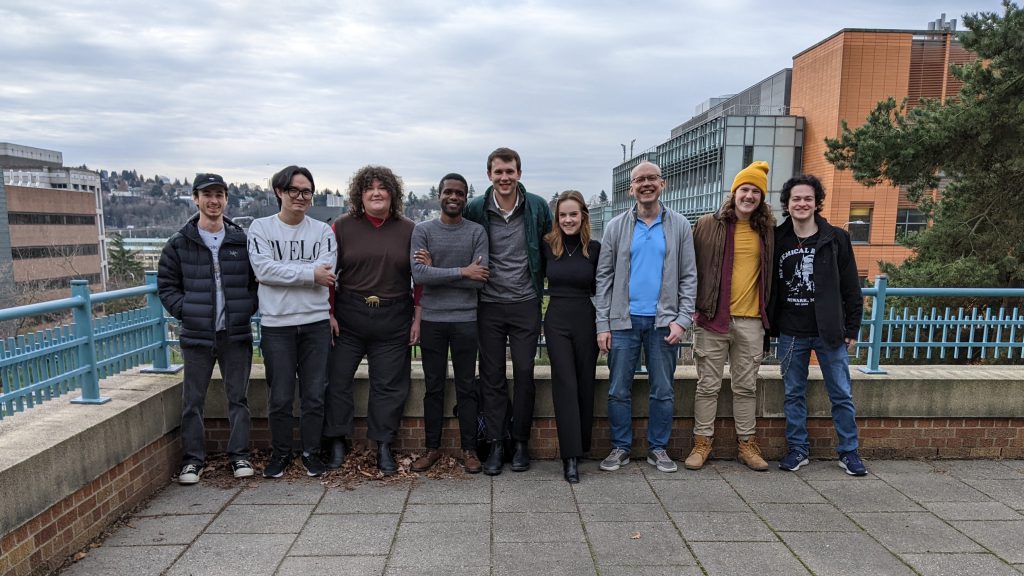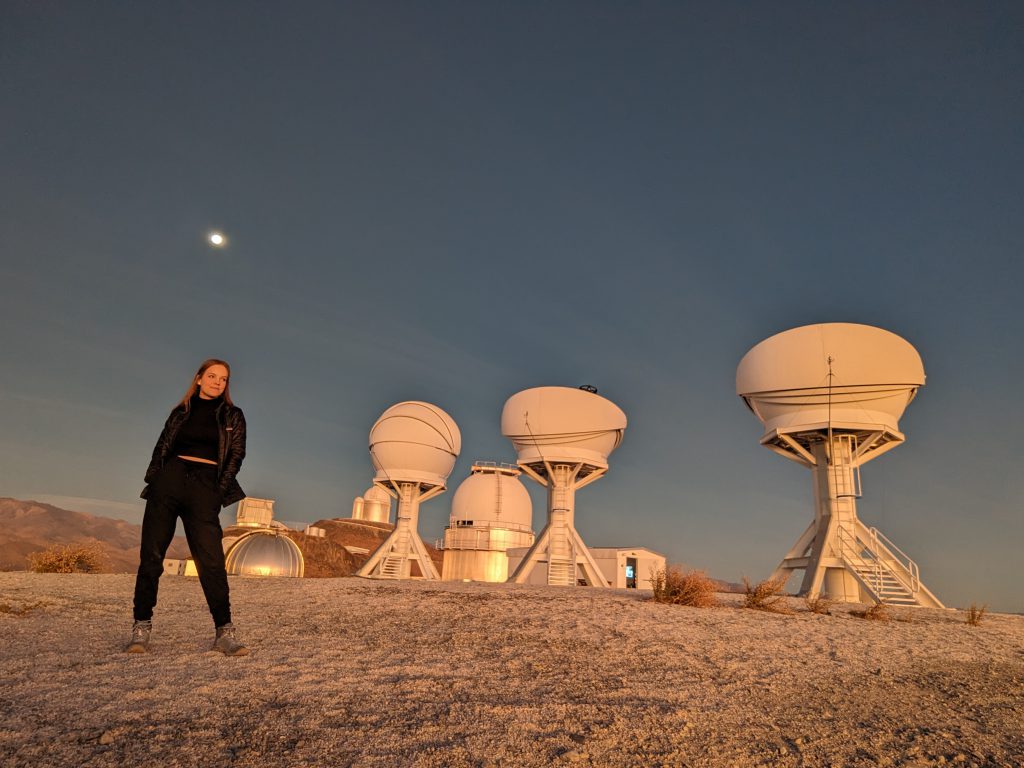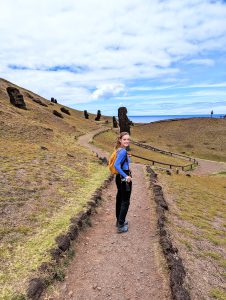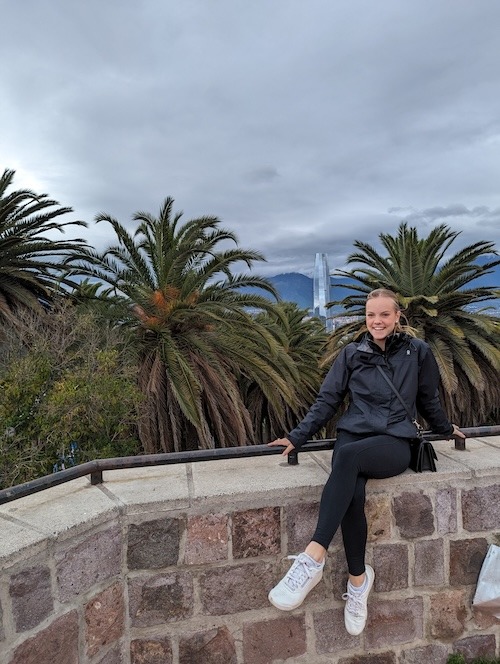April 11, 2024
As a high school student, Bellevue, WA native Audrey Budlong was a Running Start Student, a program with Bellevue College allowing high school juniors and seniors to earn college credits at the same time as high school credits. The program helped her earn an Associate of Science degree in Physics, Engineering and Atmospheric Science at the same time as she earned her high school diploma in 2019. The early exposure to STEM fields and research helped her pick a major in physics at UW and drove her to pursue quantum information science. She’s currently a second-year physics graduate student and an Accelerating Quantum Engineering and Technology (AQET) Fellow in QuantumX.
QuantumX: What interested you in getting your Ph.D. at UW and what interested you in joining AQET?
Budlong: As an undergraduate at the University of Washington, I worked on research projects in neurophysics, quantum computing, and astrophysics, as well as nuclear and particle physics. Through these enterprises, I developed a particular interest in quantum information science, inspired by my honors project with physics professor Boris Blinov. Now I’m a second-year physics graduate student in his lab.
I was drawn to the AQET program because of its interdisciplinary approach to science. Research is increasingly computationally driven and profoundly interconnected, requiring both technical and interpersonal skills. I love interacting with others and expanding my knowledge across different fields of study and this program provides a superb opportunity to do just that while tying in nicely with my current research interests.
QuantumX: Can you tell us more about your research in physics and how quantum information plays a role in it?
Budlong: The UW Trapped-Ion Lab focuses on the experimental implementation of quantum computation, quantum communication, and quantum simulation using trapped ions. Specifically, my research centers around studying correlated quantum jumps in trapped-ion systems.

Previous works have provided evidence for the presence of correlations in photon emission times within a linear chain of trapped ions, while others have found no such correlations. To date, findings have been inconclusive. Correlated emissions could prove to be an impediment to the development of quantum information processing for trapped-ion systems. My research looks for the presence of these correlations using a linear crystal of barium ions. I’ve designed new methods of determining bright and dark states for each ion and the associated times at which jumps occur. Using these tools, we look for near-simultaneous jumps and calculate the probability that the observed number of near-simultaneous transitions can be explained by random, uncorrelated ion jumps. We hope to finally answer the question as to whether photon emissions from chains of trapped ions are correlated.
Quantum X: How did Running Start change your career trajectory and interests?
Budlong: Attending Bellevue College is what got me interested in physics and I ultimately choose physics as my major at UW. Because I was able to start in junior-level courses, I began research earlier and, during my time as an undergraduate at UW, ended up working on projects in neurophysics, quantum computing and astrophysics, as well as nuclear and particle physics. These experiences led me to graduate school.
During my first year in grad school, I spoke at a few conferences at UW and local community colleges about finding undergraduate research experiences and the advantages of doing so. During these events, I realized that we needed to have more research opportunities to offer to these students. Taking this as inspiration, I approached physics Professor Miguel Morales to hear about his experience working with community college students and then ultimately develop UW Physics Program for Advanced Training in Hands-on Science (PATHS) with him. Our vision is to expand this program to encompass research groups in all STEM fields at UW and hopefully inspire other universities to follow and design their own PATHS.
For me, grad school is not only about learning and expanding my own knowledge, it’s also about making a positive impact on my community and hopefully inspiring others to pursue STEM.
QuantumX: In 2023 you were accepted into the Fulbright U.S. Student Program, where did you go and how did it relate to your research?

Budlong: First, I conducted a survey of active galactic nuclei in collaboration with the Institute of Astrophysics at the Pontificia Universidad Católica de Chile (PUC), the Chilean Active Galactic Nuclei/Galaxy Extragalactic Survey, the Multi-Object Spectrograph Telescope (4MOST), and the Rubin Observatory Legacy Survey of Space and Time (LSST). My work used existing static photometric catalogs to narrow the sample selection for the 2023 4MOST survey so it is optimized for application to active galactic nuclei (AGN) projects, giving us the ability to perform a detailed temporal analysis of their optical spectral energy distributions—essentially, to ascertain how galaxies change over time.
Second, in collaboration with PUC along with Radboud University in The Netherlands, I was one of the first graduate students in the world to physically run the BlackGEM telescopes out of the European Southern Observatory in La Silla, Chile. Complementing current observatories like the Laser Interferometer Gravitational-Wave Observatory and the Virgo Interferometer, BlackGEM telescopes are designed to quickly scan large areas of the sky and precisely hunt down gravitational-wave sources using visible light.

Third, after running the BlackGEM telescopes at La Silla, I was drawn back to work I started as an undergrad understanding and correcting for the differential chromatic refraction effect in collaboration with the Rubin Science Team. With state-of-the-art technology and a new frontier of unobserved southern skies to explore, the Rubin Observatory Legacy Survey of Space and Time (LSST) guards Earth from incoming asteroids. The algorithms we have been developing will enhance the spectral resolution of the telescope resulting in higher- accuracy templates for image subtraction and improved fidelity of asteroid detection, providing more time for impact response.
QuantumX: What advice would you give to students interested in joining or just starting the AQET program?
Budlong: AQET is an amazing opportunity. The interactions with various departments and industry partners yields an interdisciplinary, interconnected environment where advanced research skills are developed. You won’t want to miss it!
QuantumX: On top of all your research, you’re involved in several extracurricular endeavors, what are they?
Budlong: Within the University, I am the Director for PATHS. It provides immersive training and mentorship in diverse subfields of physics under the guidance of experienced researchers and faculty mentors. Participating community college students engage in cutting-edge research projects ranging from exploring the mysteries of the cosmos to unraveling the complexities of biological systems and delving into the quantum realms of information processing. Through this program, community college students acquire invaluable technical skills and scientific knowledge and develop a deep appreciation for the interdisciplinary nature of physics research, paving the way for future studies and successful careers in STEM fields.
Outside of UW, I have been the head coach for the Bellevue Junior Cheer Team since 2019. We are an all-volunteer, non-profit organization designed to make cheerleading accessible to students around the Eastside. We focus on building communities and bonds between students while creating a positive and encouraging learning environment.

